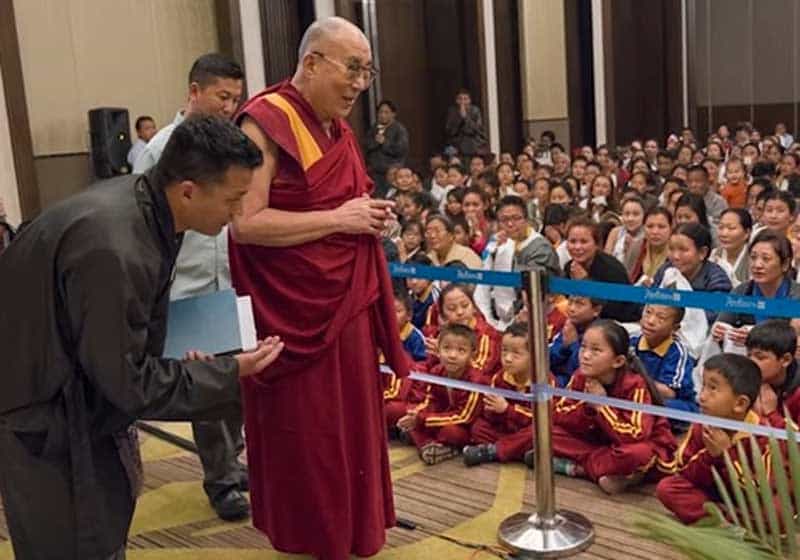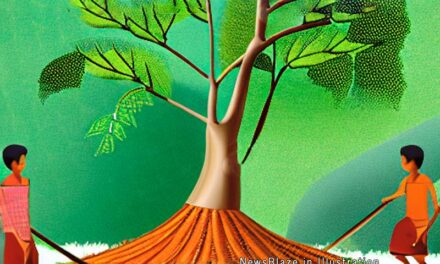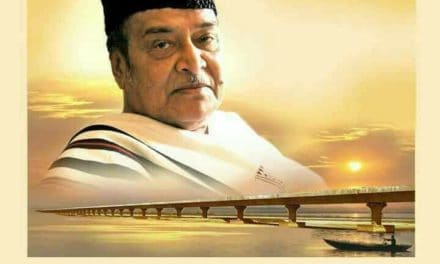Braving sudden bad weather in northeast India and ignoring the relentless threats from the Chinese government in Beijing, His Holiness the 14th Dalai Lama Tenzin Gyatso finally concluded his Tawang visit staying for days in the historic monastery of Arunachal Pradesh. The Nobel peace laureate was initially scheduled to fly to Tawang from Guwahati on 4 April, but the inclement weather compelled him to take the land route and reached Tawang on 7 April.
The octogenarian Tibetan leader, who arrived in Guwahati from Dharamshala in north India to grace a number of events in Assam, arrived in Bomdila of Arunachal’s West Kameng district in the evening of the same day. Then he climbed up to Dirang and finally reached Tawang town, which houses the second largest Buddhist monastery in the world after the Potala palace in Lhasa, Tibet.
Arunachal Pradesh chief minister Pema Khandu escorted the apex religious leader among Tibetan Buddhists from Guwahati to Tawang along the nearly 550 km hilly and snow clad road. Thousands of Tibetans wearing colourful traditional attire warmly welcomed their ‘living God’ in Tawang Gaden Namgyal Lhatse and sought blessings.
In the ancient historic city of Guwahati, the Dalai Lama graced the concluding program of The Assam Tribune’s platinum jubilee and Dainik Asom’s golden jubilee celebrations on 1 April. The next day, he attended a public function at Gauhati University, where the Assamese translation of ‘My Land and My People’ (Mor Desh Aru Mor Manuh) was released in the presence of Assam Governor Banwarilal Purohit and Assam chief minister Sarbananda Sonowal.
An emerging voice for conservation of nature also joined in the Namami Brahmaputra festival, inaugurated by President Pranab Mukherjee on 31 March on the bank of the Brahmaputra which originates in Tibetan glaciers. He visited Dibrugarh University in eastern Assam on 3 April to address a select gathering, where he emphasized internal peace for every individual.

Dalai Lama visits Tawang.
In various interactions in Assam, the Dalai Lama preached Ahimsa (non-violence) with Karuna (compassion). He also termed himself the longest tenured guest of India. He remembered those days, when the Hun Chinese invaded Tibet and he had to escape from Lhasa. He revealed that now he becomes a messenger of Indian culture to the world like a true son of the great country.
But the Chinese government continued making noises over the Dalai Lama’s visit to Tawang, a region Beijing still claims as their own, where various so-called non-government agencies and the government-controlled media outlets strongly opposed his visit to Arunachal. They argued that his visit to the disputed locality would seriously damage bilateral ties between India and China.
Banned Outfits Parrot China Line
Showing loyalty to the Beijing administration, the banned United Liberation Front of Asom (Independent), which has waged a war for decades against New Delhi for an independent Assam (Swadhin Asom), also discouraged the Dalai Lama’s visit to the region.
Even showing audacity to the spiritual leader, the armed outfit warned him not to utter a single word against Beijing from the soil of Assam, because “China has always been a friendly neighbour to Assam and the relationship between China and Assam is truly very deep in linguistic and cultural heritage of the two nations.”
In a formal letter addressing the religious leader, the self-styled chairman of Ulfa (Independent) Dr Abhizeet Asom argued that the Dalai Lama’s visit to Tawang would disturb peace and tranquility in Assam as the Chinese government was opposing any high-profile individual’s visit to Arunachal terming it a part of South Tibet.
The militant leader, whom the National Investigation Agency (of India) suspects is based in London with a different name of Dr Mukul Hazarika, wrongly pointed out that during 1962 Indo-China war, the Peoples Liberation Army (PLA) personnel “did not set foot on Assam soil,” but in reality the Chinese soldiers crossed Arunachal Pradesh and arrived at Tezpur until the Beijing administration received a warning from American authorities.
Abhizeet Asom, who was picked up by Paresh Barua – now reportedly a tenant of Ruili town in southern Chinese province of Yunnan, also criticized the Indian nationals who extended moral supports for a Free Tibet and raised voices against the Tibetan government-in-exile along with the Dalai Lama. Citing that the former Indian Prime Minister AB Vajpayee accepted Tibet as an integral part of China, the militant leader also argued that India’s first Premier Jawaharlal Nehru also officially recognized Tibet as a region of China.
The Ulfa (I) tried to make a point that New Delhi was illegally occupying Nan Zhang (South Tibet) as Assam. It also criticized Pandit Nehru for welcoming the Dalai Lama as a special guest after a failed uprising in Tibet against the Chinese invasion. Even His Holiness, who earlier accepted that Tibet is an autonomous region of China, recently commented that Tawang belongs to India and that way he supported New Delhi’s occupation over Nan Zhang.
However, on the ground the separatist militants’ reaction was endorsed by nobody with the allegation that the Ulfa (I) had slowly turned into a puppet to Red China for their shelter in south China-Myanmar border areas. China turns out to be the last refugee for Paresh Barua, who faces a death penalty in Bangladesh, after his ouster from Bhutan and also resistant from the newly formed quasi-democratic government in NayPieTaw.
Criticizing Red China
But contrary to the diktat of Ulfa (I), the Patriotic People’s Front Assam (PPFA) welcomed the Dalai Lama to the Northeast and it clarified that Tibet, not China, is the actual northern neighbor of the region. So the civil society group expressed hope that His Holiness’s visit would strengthen the bond between the people of Tibet and the northeastern region of India. The PPFA also criticized Red China for using the Ulfa (I) card against New Delhi.
The Indian external affairs ministry in a strong statement commented that “no artificial controversy should be created around religious leader Dalai Lama’s visit to Arunachal Pradesh.” The Union government has clearly stated on several occasions that the Dalai Lama is a revered religious leader, who is deeply respected as such by the Indian people. Hence no additional colour should be ascribed to his religious and spiritual activities and visits to various states of the country, a ministry statement said.
Earlier the Union minister Kiren Rijiju, who hails from Arunachal commented that the Dalai Lama’s visit materialized because of the Arunachali peoples’ long standing demand. The young minister clarified that his visit to the Tibet bordering Indian State was completely religious and no political angle behind his visit should be ascribed. “Arunachal is an inseparable part of India and China should not object to His Holiness’s visit to the State. It’s an India’s internal affair,” said Rijiju, who practices Buddhism and strongly commented that New Delhi had never interfered in China’s internal affairs and it expect Communist China also to reciprocate.
China Statements
As the international media poured news with the Dalai Lama’s visit to Arunachal, the Chinese foreign ministry in Beijing came out with the statement that hosting the Tibetan leader “on a contested stretch of land on the India-China border” New Delhi has caused serious damage to the relations between the two neighboring countries.
The Chinese foreign ministry spokeswoman Hua Chunying commented that Beijing firmly opposed the visit by a man (the Dalai Lama) whom the Chinese government labels “a dangerous separatist” to the disputed border region and New Delhi would benefit nothing out of it. Rejecting the arguments that the Dalai Lama’s trip was solely religious in nature, Chunying informed Beijing would lodge a formal protest with New Delhi in this regard.
However, the Dalai Lama clarified during a media interaction at Bomdila that New Delhi had never used him against Beijing. India is a land of peace, harmony, non-violence with secular ethos, he disclosed. The spiritual leader also urged the Chinese government to offer the Tibetans genuine autonomy and meaningful self-rule (if not independence).
Meanwhile, the Arunachal government chief Pema Khandu asked China not to tell India “what to do and what not to do with His Holiness’s movement inside the country.” He even asserted that China is not Arunachal’s next-door neighbor (but Tibet). The McMahon Line demarcates the boundary between India and Tibet, the young chief minister claimed.
The Dalai Lama previously visited Arunachal Pradesh in 1983, 1997, 2003 and 2009. Every time China reacted sharply, New Delhi responded with softer words. But with a new regime led by Bharatiya Janata Party in New Delhi under Prime Minister Narendra Modi, the situation turned different and it remains smarter to Beijing’s attitude.
In fact, it started with the swearing-in ceremony of the new regime in 2014, when PM Modi preferred to invite the Tibetan government-in-exile head Lobsang Sangay along with all neighboring country leaders in power (avoiding Red China). Lately President Mukherjee also hosted the Dalai Lama at his official residence in the national capital, which was the first meeting of the Tibetan leader with an Indian head in the last six decades.




